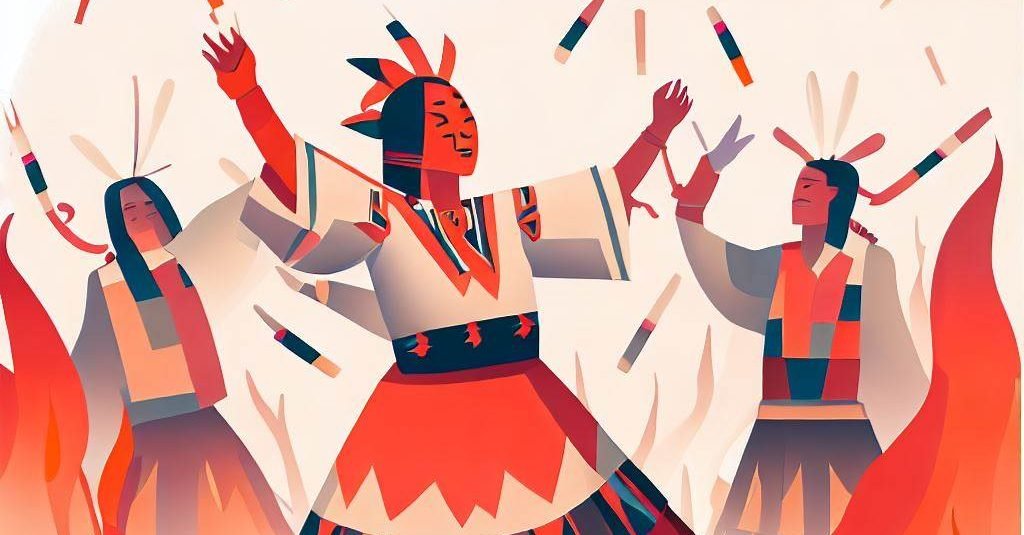The Navajo Blessingway Ceremony: A Celebration of Harmony and Balance
The Blessingway ceremony is a cornerstone of Navajo spiritual and cultural life, reflecting the central role of the Hózhǫ́ principle in the Navajo worldview. As a rite of passage, healing, and celebration, the Blessingway serves to restore balance and harmony within individuals and communities, fostering overall well-being and interconnectedness. This article delves into the meaning, structure, and significance of the Blessingway ceremony within the Navajo culture.
The Meaning and Purpose of the Blessingway Ceremony:
At its core, the Blessingway ceremony embodies the Navajo concept of Hózhǫ́, which encompasses balance, beauty, harmony, and well-being. The ceremony is performed to mark significant life events and transitions, such as births, marriages, and healings, and serves as a means to restore and maintain Hózhǫ́ in the lives of individuals and communities.
The Blessingway ceremony seeks to realign people with the principles of Hózhǫ́, promoting balance and harmony within the self, relationships, and the natural world. Through prayer, song, ritual, and storytelling, participants are guided on a spiritual journey that reconnects them with the sacred elements of the universe and reaffirms their place within the web of life.
Structure and Elements of the Blessingway Ceremony:
While the specific structure and elements of the Blessingway ceremony can vary depending on the occasion and the Navajo medicine man or singer who leads it, several key components are common to most Blessingway ceremonies:
- Prayer and Song:
Prayers and songs play a vital role in the Blessingway ceremony, invoking the presence and guidance of the Holy People (Diyin Dine’é) and expressing gratitude for the blessings of life. These prayers and songs are often performed in a specific sequence, with each chant corresponding to a particular stage of the ceremony. - Storytelling:
The Blessingway ceremony includes the recounting of Navajo creation stories and other traditional tales, which serve to remind participants of their cultural heritage and their connection to the Holy People. These stories also impart important moral and spiritual lessons, reinforcing the values of Hózhǫ́. - Ritual Objects and Offerings:
Various ritual objects and offerings are used throughout the Blessingway ceremony, such as corn pollen, eagle feathers, and turquoise. These items hold symbolic significance within the Navajo culture and are believed to facilitate communication with the Holy People. - Sandpainting:
In some cases, a sandpainting may be created as part of the Blessingway ceremony, serving as a sacred and temporary artwork that represents the spiritual journey of the participants. The sandpainting is meticulously crafted using colored sand and other natural materials, and it is destroyed upon the completion of the ceremony to symbolize the impermanence of life.
The Importance of the Blessingway Ceremony:
The Blessingway ceremony holds immense significance within the Navajo culture, serving as a vital means of preserving and transmitting traditional knowledge, values, and practices. By participating in the Blessingway, individuals are not only reaffirming their connection to the Holy People and the natural world but also strengthening the bonds of kinship and solidarity within their community.
Moreover, the Blessingway ceremony serves as a powerful reminder of the importance of living in accordance with the principles of Hózhǫ́, promoting balance, harmony, and well-being in all aspects of life. In this way, the Blessingway helps to nurture a strong sense of identity, purpose, and interconnectedness among the Navajo people.
Conclusion:
The Navajo Blessingway ceremony is a rich and multifaceted tradition that plays a crucial role in the spiritual and cultural life of the Navajo people. By exploring the meaning, structure, and significance of the Blessingway ceremony, we gain a deeper understanding of the values and principles that underpin the Navajo worldview and way of life. As an expression of the Hózhǫ́ concept, the Blessingway ceremony serves not only as a vehicle for healing and celebration but also as a potent reminder of the importance of balance, harmony, and interconnectedness in our increasingly complex and interconnected world.
Key Sources Consulted:
- Faris, James C. “The Nightway: A History and a History of Documentation of a Navajo Ceremonial.” University of New Mexico Press, 1990.
- Kluckhohn, Clyde, and Dorothea Leighton. “The Navajo.” Harvard University Press, 1946.
- McNeley, James Kale. “Holy Wind in Navajo Philosophy.” University of Arizona Press, 1981.
- Reichard, Gladys A. “Navajo Medicine Man: Sandpaintings and Legends of Miguelito.” Dover Publications, 1990.
- Witherspoon, Gary. “Navajo Kinship and Marriage.” University of Chicago Press, 1975.
- Wyman, Leland C. “Blessingway: With Three Versions of the Myth Recorded and Translated from the Navajo by Father Berard Haile, O.F.M.” University of Arizona Press, 1970.

